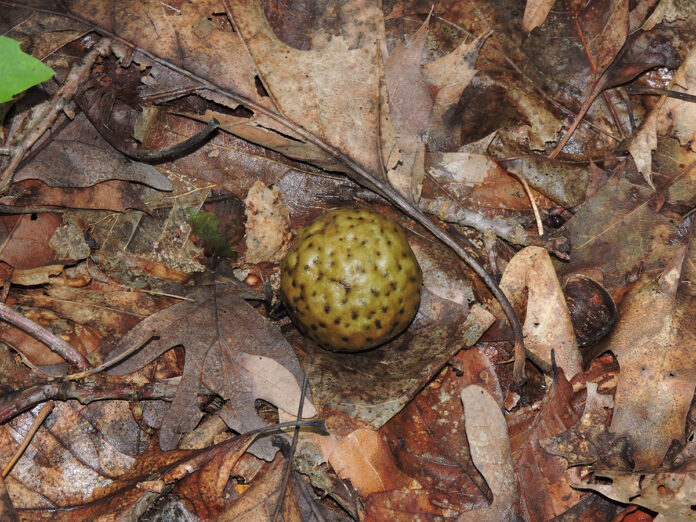
This is the time of year when the inquiries start rolling in about the mysterious brown paper-like balls that are suddenly appearing on the forest floor or that can be seen attached to leaves of oak trees. These perfectly round structures, which are more numerous some years than others, resemble small apples. Oak apple galls measure just under 2 inches in diameter and are completely harmless to both you and their host tree.
A gall, in general, is an abnormal growth found on a plant, caused by the eating or egg laying activity of an insect. These deformities can be found on leaves, stems or flowers and come in an amazing variety of shapes, colors, sizes and textures. Galls can be smooth, fuzzy, spiny, colorful, sizeable or tiny, and each type of gall is the work of a particular species of insect.
In the U.S., there are nearly 1,500 species of insects that produce galls as part of their life cycle, and each species makes their galls on only one particular area of one type of plant. Each has its own timing as to when gall creation will occur, and most importantly, the size and shape of the gall is indicative of the species that created it.
Oak apple gall

Gall formation follows the same general principles for most insects, so for this account, we will explore the formation of the oak apple gall in depth. The largest group of gall-creating insects are the gall wasps of the family Cynipid, a group that prefers oaks and roses. A gall wasp need not be feared, as it is a tiny, harmless sprite that can be spied by only the keenest of eyes.
The spongy oak apple gall wasp (Amphibolips confluent) has an interesting lifecycle that spans the course of two years, all of which is centered upon a single oak tree. Preferring red, black or scarlet oaks, the wasp’s life cycle begins underground where the tiny larvae hatch from eggs and take their sustenance from the roots of the tree. For an entire spring and summer, they feed beneath the soil, finally forming tiny pupae which then overwinter among the rhizomes. As the insects’ second spring arrives, they emerge from their pupae and make their way up through the soil. Females are wingless and slowly make their way up into the branches of the oak and out onto the leaves.

A female gall wasp has but one objective, to deposit her eggs. Finding a newly forming leaf, she carefully deposits a single egg into its central vein. Along with this egg she injects special chemicals, hormones that aid in the creation of the gall structure itself by altering the leaf’s typical growth pattern. Slowly, the affected section of leaf begins to grow, aberrantly, around the egg, starting as a small ball and growing larger as the leaf matures. Inside, thin fibers extend from the outer walls of the gall toward the center where a tiny cell sits, suspended at the core, resembling a starburst. All within the safety of this little chamber, the tiny larvae feeds, grows and matures. Sometime in midsummer, it achieves full growth and forms a pupa. A short time later, a mature spongy oak apple gall wasp emerges, first chewing its way out of the inner chamber, then exiting through the papery outer wall of the gall. One can easily determine if the gall wasp has emerged by searching for a perfectly round exit hole in the side of the structure. After emergence, the gall itself turns from green to brown and often falls to the ground.

As the adult wasps emerge from the galls, they immediately search out mates, pairing up to ensure fertile eggs for another generation. The gravid females then burrow down into the soil to deposit their eggs among the roots of an oak tree. Thus, the cycle begins again.
Having lived in northeast Ohio my entire life where oak trees abound, oak apple galls have always been part of the landscape. In fact, I’ve been messing around with them most of my life. I like to take the spent brown galls and cut a window in the side. This gives me a clear view of the star-like structure within, the supported chamber usually sporting a round hole where the adult wasp emerged.
It’s also interesting to do this when the gall is still green and growing, still harboring the tiny larvae within. One day it occurred to me that I had never glimpsed the adult wasp. So, I searched until I found an oak apple gall that did not have the tell-tale round exit hole. I placed it in a cage and proceeded to check on it every few days. Finally, one day I noticed a diminutive wasp flying around inside and quickly realized from the hole on the side of the gall that it had finally emerged. Apparently, their life span is quite short, for when I returned the following day with camera in hand, the tiny vespa had expired.

Examining the gall wasp closely, I could see its characteristic hunch-backed appearance (typical of this wasp family), the shiny abdomen and the ornate markings on its wings. It was a marvelous little specimen. Having finally witnessed all aspects of this insect’s life cycle, I couldn’t help but ponder how such a tiny, seemingly insignificant species could be capable of such an intricate and fascinating transformation happening right beneath our noses. It truly is yet another one of nature’s wonders.











